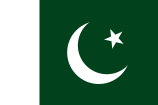Source
http://news.bbc.co.uk/
March,05,2010
Pakistan : In April each year, thousands of Hindus flock to the cave temple of Hinglaj Mata, situated in a remote, desolate and hilly area of Pakistan's Balochistan province, 250km (155 miles) north-west of Karachi.
The high point of the four-day pilgrimage comes on the third day when high priests chant mantras, inviting gods to accept the offerings of the devotees and bring them peace and plenty.
Each devotee makes an offering of three coconuts at the temple of Hinglaj Mata, or the goddess Sati. According to a Hindu myth, Lord Vishnu cut up the dead body of Sati with his flaming disc into 50 pieces, which fell to the earth. Her head fell at Hinglaj.
Pilgrims come from all over Pakistan, carrying red banners and wearing decorative red-and-gold head-scarves or saffron headbands that signify the holy colours of Hinglaj Mata.
Organisers of the pilgrimage estimate that between 25,000 and 30,000 devotees visited the Hinglaj Mata temple this year. The numbers have grown over the past three years due to the opening of the highway that connects Karachi with Gwadar.
Most pilgrims come in buses, some come in private cars. Others, like Chetan Ram, Tagu Ram and Jugtia Ram, came on bicycles all the way from Karachi. The greater the suffering, they say, the greater the reward.

Before the partition of India in 1947, more than 20% of the population of today's Pakistan was Hindu. But many left the country at the time of partition in 1947. Today many Hindus say they are still discriminated against or forced to convert to other religions.

Thar, a south-eastern district of Sindh province, houses more than 2.3 million Hindus, the largest Hindu population in a single district outside India. There are some traders and government employees among them, but a huge majority are farm workers and bonded labourers.
With their heavily embroidered clothes and wrists packed with bangles, Thari Hindus clearly dominate the Hinglaj pilgrimage in terms of numbers.
Balochistan province is also home to a large number of Hindus, and the local Muslim population has traditionally venerated and protected Hindu sites, such as the temple of Hinglaj Mata which the local Muslims call Nani Mandir, or the grandmother's temple.
A highlight of the Hinglaj pilgrimage this year was a group of Balochistani Hindu priests collecting donations for a Hindu temple being built in Quetta, the provincial capital.
For four days every year, the mountain desert around Hinglaj turns into an oasis of hospitality. Hundreds of volunteers help with a range of activities such as regulating the parking of hundreds of buses, jeeps, cars and trolleys, arranging water for the pilgrims, operating electricity generators and running the kitchen where tons of wheat flour, rice, lentels and vegetables are cooked three times a day to feed the pilgrims. All adults pay 650 rupees ($11) per head to finance this activity.
While a huge majority of the pilgrims are lower class labourers from rural Pakistan, some middle-class families from Karachi also make the annual pilgrimage. Karachi is home to about 70,000 Hindus and is the first stop of the pilgrims on their way to Hinglaj.
For children, it is great fun - especially for Thari children who remain confined to agricultural farms where many of them work as bonded labourers the whole year round.
Given their precarious social position in a feudal-dominated system, many of them will never be able to return to Hinglaj for a long time. But they can cherish the memory.
(Text and photos by M Ilyas Khan)






















really interesting ,seeing the temples in pakistan, and peoples of that country doing worship .from out side picture looks different. i think all the human being are same only leaders and contractor of religion exploit the situation for his benefit.after partition of country only innocent people were killed , no leaders were killed at the time of partition.
ReplyDelete